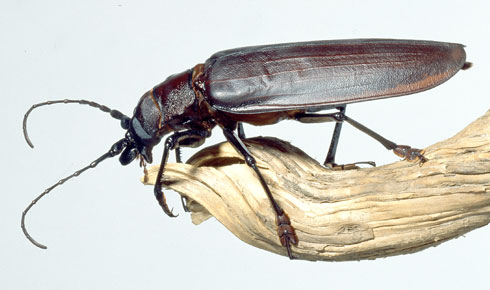Titanus giganteus (titan longhorn, titan beetle)
Titanus giganteus is the world’s biggest beetle. The largest recorded specimen was a 16.7cm long male - longer than some small adult Chihuahua dogs - and was collected in French Guiana by entomologist Patrick Bleuzen.
In spite of its imposing size, large jaws, sharp spines, and the ability to hiss and to fly, Titanus are quite harmless to humans.
They live unobtrusively, deep in some of the world’s hottest tropical jungles, where the giant grubs recycle decaying wood below ground. The adults are active for a few weeks, seeking out a mate during the hottest and most humid time of the year.
Like most inhabitants of the rainforest, this magnificent giant insect is threatened by the destruction of its forest home for timber and agriculture.
Species detail
-

Taxonomy
Many people think Titanus giganteus resembles a huge cockroach, but it is a true beetle. Find out how we know.
-

Distribution
Titanus giganteus is found in tropical rainforests close to the equator in South America. The larvae feed on buried wood and thrive in areas with decaying tropical hardwood trees. Find out more.
-

Biology
Beetles in the subfamily Prioninae feed as larvae on decaying wood, and take years to mature. When the adults finally emerge, they reproduce and die in just a few weeks. But these beetles are impressive. Discover how they defend themselves when threatened.
-

Behaviour
Titanus beetles are nocturnal and are attracted to artificial light. Read on to discover how light-trapping is used to collect beetle specimens and how earlier specimens were found.
-

Conservation
Titanus giganteus is popular with collectors and dealers and, ironically, this may help protect the species. Discover why collecting beetles from tropical forest areas may benefit the whole ecosystem.
-

Size and appearance
Rumour has it that Titanus giganteus can grow to over 20cm long. Uncover the facts behind the fiction.
Images

Titanus giganteus: female, collection specimen.

A male Titanus giganteus takes to the air.
© Natural History Museum, London
Light trapping in the South American jungle.
© Howard Mendel, Natural History Museum, London
Some of the most intact tropical rainforests, with the largest trees, are accessible only by boat or helicopter. That is why they remain so intact!
© Conrad Gillett
Titanus giganteus.
© Natural History Museum, London
Insects from a night's light-trapping in French Guiana being mounted, including 3 male Titanus giganteus.
© Conrad Gillett
Conrad Gillett, PhD student and former curator at the Natural History Museum, holds 2 specimens of Titanus giganteus in French Guiana.
© Conrad GillettAbout the author

Max Barclay
Collections manager of the Museum's Coleoptera and Hemiptera collections. Responsibilities include managing a team of curators, administering loans, processing new material and facilitating collection access for visitors.
A word from the author
"For those people who think there is something arcane and unapproachable about scientific names, think again! The Latin name of today’s species is Titanus giganteus, which perfectly and succinctly describes the world’s largest beetle. In spite of its huge size, there is still a great deal that we don’t know about this denizen of the South American rainforests."
